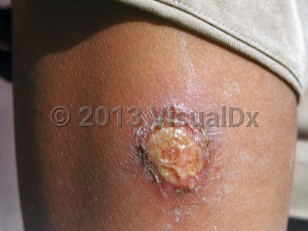Yaws in Child
Alerts and Notices
Important News & Links
Synopsis

Yaws, also known as framboesia, pian, buba, parangi, and paru, is an endemic treponemal infection caused by the spirochete Treponema pallidum ssp pertenue. It is found in rural areas of Central and South America, equatorial Africa, the Caribbean, and the equatorial islands of Southeast Asia, including Papua New Guinea. It is considered a disease of children, with a peak incidence between the ages of 2 and 10 years. The disease is spread by person-to-person contact, and risk factors include broken skin, overcrowding, and poor sanitation.
Clinical features can be categorized into early (primary and secondary), latent, and late (tertiary) stages. After an incubation period of 3 weeks (9-90 days), yaws presents as a small papule that rapidly enlarges to a size of around 2-5 cm. Termed the mother yaw, or frambesioma, this primary lesion is teeming with spirochetes, very pruritic, and extremely infectious.
The mother yaw may persist for 3-6 months before spontaneous resolution (sometimes with scarring or hypopigmentation, sometimes without). During the primary stage, the organism disseminates hematogenously and via the lymphatic system to give rise to secondary yaws weeks to months later.
In secondary yaws, scaly or moist papules, plaques, and nodules in localized, intertriginous, or generalized distributions occur. Oral mucous patches may be seen. This may be accompanied by fever, malaise, and generalized nonsuppurative lymphadenitis. Osteitis, periostitis, and dactylitis may also be seen at this stage. The cutaneous lesions last for weeks to months and resolve completely or with residual hypo- or hyperpigmentation.
Ten percent of individuals develop late-stage yaws after a latent period of 5-10 years. Recurrent self-healing skin and oral lesions may occur during this latent period. Late-stage yaws is marked by chronic skin ulcers (gummas) and painful, destructive bony changes.
Clinical features can be categorized into early (primary and secondary), latent, and late (tertiary) stages. After an incubation period of 3 weeks (9-90 days), yaws presents as a small papule that rapidly enlarges to a size of around 2-5 cm. Termed the mother yaw, or frambesioma, this primary lesion is teeming with spirochetes, very pruritic, and extremely infectious.
The mother yaw may persist for 3-6 months before spontaneous resolution (sometimes with scarring or hypopigmentation, sometimes without). During the primary stage, the organism disseminates hematogenously and via the lymphatic system to give rise to secondary yaws weeks to months later.
In secondary yaws, scaly or moist papules, plaques, and nodules in localized, intertriginous, or generalized distributions occur. Oral mucous patches may be seen. This may be accompanied by fever, malaise, and generalized nonsuppurative lymphadenitis. Osteitis, periostitis, and dactylitis may also be seen at this stage. The cutaneous lesions last for weeks to months and resolve completely or with residual hypo- or hyperpigmentation.
Ten percent of individuals develop late-stage yaws after a latent period of 5-10 years. Recurrent self-healing skin and oral lesions may occur during this latent period. Late-stage yaws is marked by chronic skin ulcers (gummas) and painful, destructive bony changes.
Codes
ICD10CM:
A66.9 – Yaws, unspecified
SNOMEDCT:
70647001 – Yaws
A66.9 – Yaws, unspecified
SNOMEDCT:
70647001 – Yaws
Look For
Subscription Required
Diagnostic Pearls
Subscription Required
Differential Diagnosis & Pitfalls

To perform a comparison, select diagnoses from the classic differential
Subscription Required
Best Tests
Subscription Required
Management Pearls
Subscription Required
Therapy
Subscription Required
References
Subscription Required
Last Reviewed:07/29/2019
Last Updated:01/18/2022
Last Updated:01/18/2022

